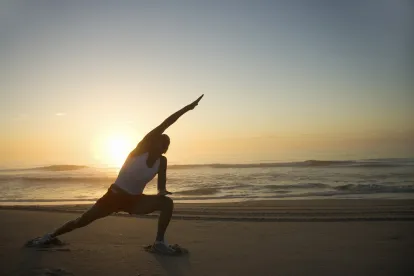In a recent decision, the U.S. Court of Appeals for the Ninth Circuit held that a certain yoga sequence developed by legendary yoga teacher Bikram Choudhury was not eligible for copyright protection. The Court’s decision was based on the fundamental copyright principle known as the “idea/expression dichotomy,” which states that copyright protection is limited to the expression of ideas, and cannot extend to the ideas themselves. The Court concluded that because the yoga sequence is an idea, process or system designed to improve health, copyright can protect only the words and pictures that are used to describe the yoga sequence (i.e. the book in which the sequence is described), but cannot be extended to protect the idea of the sequence itself.
As a bit of interesting background, Bikram Choudhury, founder of the worldwide Yoga College of India, began his yoga career in India at the ripe age of four years old. After he immigrated to the US in the 1970s, he opened a yoga studio and began offering classes in which a sequence of twenty-six yoga poses and two breathing exercises (known as the “Sequence”) was practiced over the course of ninety minutes in a room heated to 105 degrees Fahrenheit (intended to mimic the climate of India). Bikram soon became a central figure in the yoga community in the US, including among the celebrity circuit and professional athletes. In 1979 he published a book titled Bikram’s Beginning Yoga Class, in which the Sequence was described. Bikram registered the book with the Copyright Office in 1979, and in 2002 registered a “compilation of exercises” contained in the book.
The roots of the present dispute were planted in the 1990s, when Bikram introduced the “Bikram Yoga Teacher Training Course.” The defendants in the present case completed Bikram’s course, and subsequently began offering “hot yoga” classes in their own studio, in which a style of yoga similar to the Sequence was taught. Bikram then filed a complaint alleging that the defendants infringed Bikram’s copyright.
Of course, to prove a claim of copyright infringement, a plaintiff must first prove it has a valid copyright. This is where Bikram did a “downward dog.”
First, the Court noted that the Sequence is a “system” or “method,” which was designed to “systematically work every part of the body, to give all internal organs, all the veins, all the ligaments, and all the muscles everything they need to maintain optimum health and maximum function.” Thus, the Court went on, Bikram’s attempt to secure copyright protection for a healing art, or a system designed to yield physical benefits and a sense of well-being, was precluded by the idea/expression dichotomy. Essentially, the idea/expression dichotomy, which is codified in 17 U.S.C. § 102(b),
strikes a definitional balance between the First Amendment and the Copyright Act by permitting free communication of facts [and ideas] while still protecting an author’s expression.
The Court next addressed Bikram’s contention that the Sequence was entitled to copyright protection as a “compilation.” A compilation is “a work formed by the collection and assembling of preexisting materials or of data that are selected, coordinated, or arranged in such a way that the resulting work as a whole constitutes an original work of authorship.” 17 U.S.C. § 101. The Court noted that while a compilation may be eligible for copyright protection, it must nevertheless represent an “original work[] of authorship,” as required by Section 102. The Court held that the fact that the Sequence may possess many constituent parts did not transform it into a proper subject of copyright protection.
The Court then rejected Bikram’s argument that the Sequence was entitled to copyright protection as a “choreographic work.” Although a “choreographic work” is a statutory category of work entitled to copyright protection, this term has not yet been defined in the copyright context by the Court or by Congress. Nevertheless, the Court noted that defining the term was not necessary, since regardless of category, the work must meet the originality requirement imposed by Section 102. Thus, the Court held:
The Sequence is not copyrightable as a choreographic work for the same reason that it is not copyrightable as a compilation: it is an idea, process, or system to which copyright protection may in no case extend.
As long as this case law is upheld and followed, proprietors of yoga sequences and similar matter will have a difficult time in getting past the “idea/expression dichotomy” hurdle, and may have to say “neti-neti” to copyright protection. However, other forms of intellectual property protection may be available. For example, in this case, the Court specifically noted that “if [the Sequence] is entitled to protection at all, that protection is more properly sought through the patent process.” Additionally, proprietors can adopt and develop good will in a brand for the specific services associated with their sequences or similar matter (such as educational services in which the matter is taught), and rely on trademark law to prevent others from offering similar services under a similar mark.
Until the next yoga move in the IP arena, Namaste.




 />i
/>i


